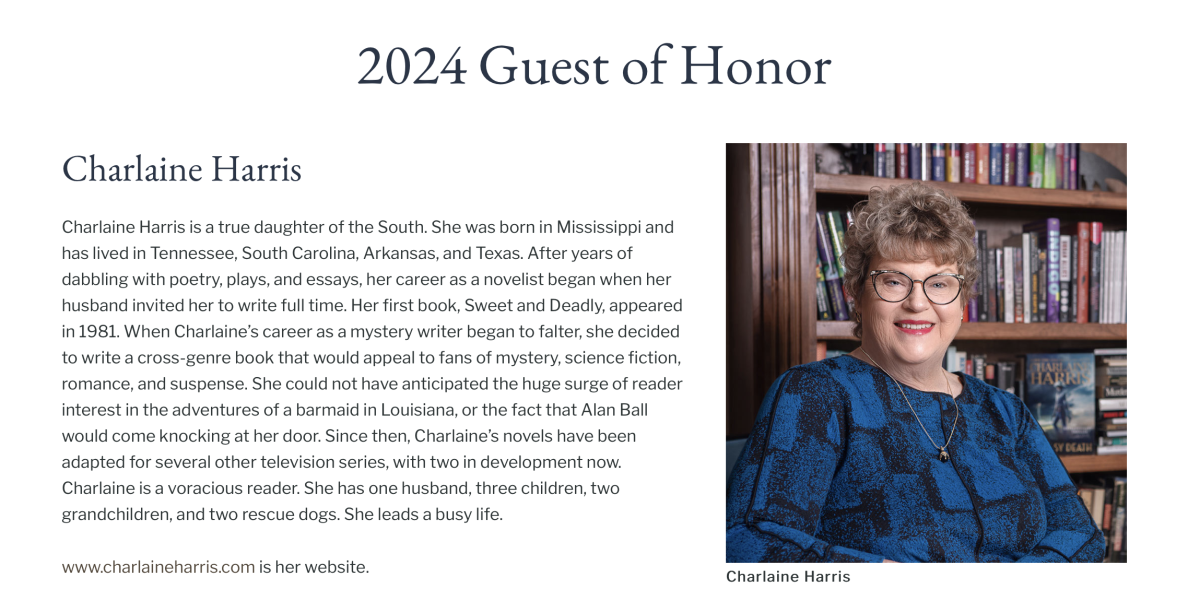For the past 15 years, Writers’ Police Academy has offered a plethora of specialized classes designed to help writers evoke a sense of hyperrealism in their stories. The event’s unique hands-on training sessions stimulate the senses of participants, enabling them to convert those real-life experiences and emotions into believable fiction. Our goal is to help attendees develop and write accurate, realistic, and compelling scenes and characters.
This year we’ve decided to focus our attention on the crime of murder since that’s a major plot point in crime fiction. Therefore, we created Killer Con, a hands-on homicide and crime scene investigator training academy. This special event is designed to guide writers through the various stages of investigations.
Yes, participants will experience what it’s like to enter a crime scene as an investigator.
To guide attendees through the processes, we are pleased to feature top-tier law enforcement instructors and forensics experts as presenters. They are undoubtedly some of the best in the business, and their sessions are magnificent. Prepare yourself to be amazed.
So, without further ado, it is my pleasure and honor to introduce you to the second group of 2024 Killer Con presenters, beginning with these three (in no particular order). Also included are the classes offered by each presenter. More to come in the days following this post.
Processing and Preservation of Fingerprint Evidence
Learn and apply the same fingerprinting tools, techniques, and skills taught to and utilized by police investigators and other crime scene investigation professionals. Attendees locate, develop, lift, and preserve latent prints from a variety of surfaces. There is more to this process than meets the eye, and certainly more to it than is depicted on TV shows. Hands-on training.
Location – CC205
Instructor – Ian Nishimoto, Master Instructor – Defensive and Arrest Tactics, Firearms/Tactical Rifle, Scenario Assessment, Tactical Response
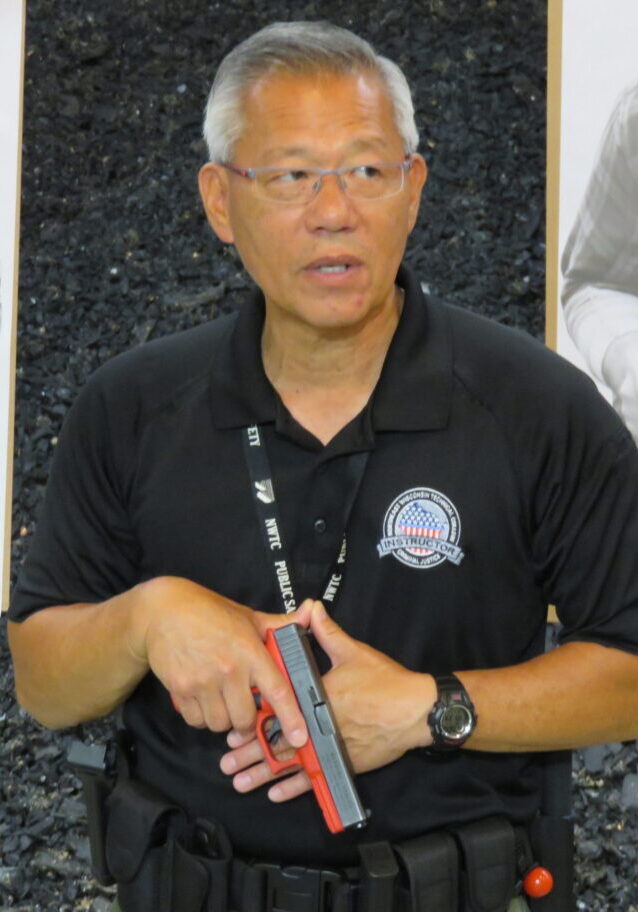 Ian Nishimoto’s mother and father were born and raised in Hawaii. His father served in the US Army for 30 years, allowing Ian to live in many areas of the United States and hence his place of birth was Staten Island, New York. Ian completed his master’s degree at the University of Wisconsin—Stout in Training and Development. He began his 30+ years of law enforcement experience at the Outagamie County Sheriff’s Department as a deputy sheriff and worked part-time for U.S. Marshal Service and other local agencies. He recently retired after 25 years of teaching from Northeast Wisconsin Technical College, where he instructed in the Police Academy and the Law Enforcement Associate Degree program. Ian is a certified master instructor in Defensive and Arrest Tactics, Firearms/Tactical Rifle, Scenario Assessment and Tactical Response. He is currently an adjunct faculty member at NWTC.
Ian Nishimoto’s mother and father were born and raised in Hawaii. His father served in the US Army for 30 years, allowing Ian to live in many areas of the United States and hence his place of birth was Staten Island, New York. Ian completed his master’s degree at the University of Wisconsin—Stout in Training and Development. He began his 30+ years of law enforcement experience at the Outagamie County Sheriff’s Department as a deputy sheriff and worked part-time for U.S. Marshal Service and other local agencies. He recently retired after 25 years of teaching from Northeast Wisconsin Technical College, where he instructed in the Police Academy and the Law Enforcement Associate Degree program. Ian is a certified master instructor in Defensive and Arrest Tactics, Firearms/Tactical Rifle, Scenario Assessment and Tactical Response. He is currently an adjunct faculty member at NWTC.
Ian and his wife have been married for 41 years, and currently reside in Oneida, Wisconsin. They have two daughters, two sons, and five grandchildren.
Processing and Preservation of Fingerprint Evidence

Body Trauma and Gunshot Wounds
Curtis Greene knows the information writers need to breathe life into shooting and trauma scenes in crime novels, having “been there, done that” for nearly two decades as a Coroner for Manitowoc County WI, serving as a Paramedic for 24 years, and managing the Emergency Room, Ambulance, Lifeline and Specialized transport division for a major hospital.
In this course, Greene shares his first-hand knowledge and experience of the effect gunshots and various injuries have on the human body. Class includes images of a variety of wounds and trauma.
Location – CC212
Instructor – Curtis Green, Elected Coroner, AS-EMTP (retired), ABMDI-F (retired)

Curtis Green
Curtis Green is currently the Elected Coroner for Manitowoc County WI. He has held this position for 16+ years and is serving his final term in that position.
He earned his basic EMT certification in 1983 and became licensed as Wisconsin’s youngest Paramedic in 1985. He began his career at County Rescue Services, Metro Ambulance Service and several other services including time in Los Angeles and San Bernardino Counties CA. After leaving California he managed the largest Air Ambulance Service in the United States, American Medical Transport, based out of Milwaukee WI. He served as a paramedic for a total of 24 years. He was a Department Head for Manitowoc Memorial Hospital in the late 80’s managing the Emergency Room, Ambulance, Lifeline and Specialized transport division. He was the owner of one of Wisconsin’s largest specialized transport services for 16 years and was responsible for approximately 350,000 specialized transports annually.
Curtis was a founding member of Prevent Suicide- Manitowoc County. An organization formed to help reduce the number of suicides and to help families cope with suicide deaths. His commitment to this cause is deep-seated in Curtis. He has had immediate family members die by suicide and homicide and brings a level of empathy to this cause from a unique perspective.
Curtis saw a need for drug prevention and education as the deaths from drug overdoses began to rise in the earlier 2000’s. Curtis has been providing education and training for those affected by drug overdose deaths and the collateral damage drug addiction inflicts on families, friends, EMS and Law Enforcement professionals. For his volunteer work, Curtis was honored to receive the 2015 Health Award from the Manitowoc County United Way. Curtis plans to continue to provide continuing education to Law Enforcement, EMS and Death Investigators following his retirement in 2027.
Curtis has 4 daughters and 6 grandchildren and lives on the hobby farm where his children were raised. He enjoys spending his limited free time at his off-grid 176 acres of riverfront property in the north woods of Wisconsin.
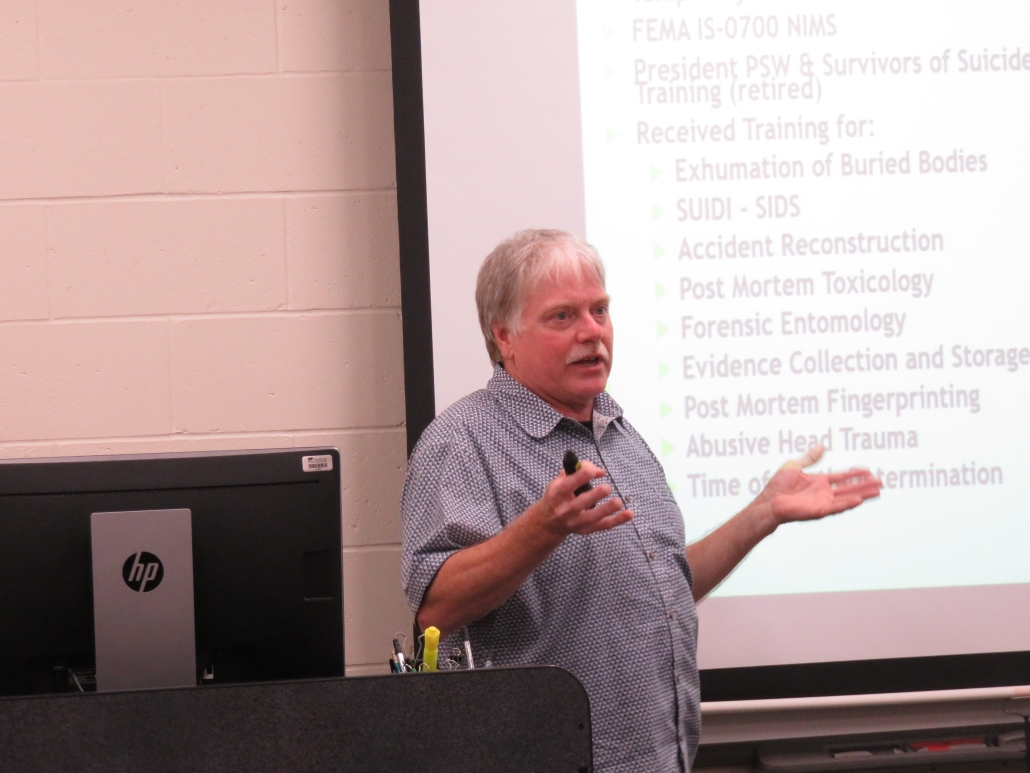
Coroner Curtis Green – 2023 Writers’ Police Academy
Virtual Reality – Mental Health Training Simulator
Officers are in regular contact with individuals who are undergoing a personal crisis, such as problems relating to the opioid epidemic, someone diagnosed on the autism spectrum, or one of a variety of psychiatric issues. Dealing with those situations can be challenging for law enforcement, especially when they often occur within mere seconds of arrival at a scene. There is often no time to know or research the person’s history, background, or medical diagnosis; therefore, officer responses to the situations are often reactionary to what is sometimes perceived as violent threats to their safety or the safety of others, including that of the person in crisis.
Virtual reality mental health training simulators place law enforcement officers into the shoes and minds of those suffering from an emotional disturbance or experiencing a mental health crisis. This realistic training experience helps police better comprehend what these individuals are experiencing, and to recognize and understand how to handle a subject who is undergoing psychiatric distress.
Killer Con attendees have the unique opportunity to participate in this hyper-realistic, eye-opening training experience.
Location – SC142
Instructor – Erik Walters, Public Safety Training Complex Specialist – Wisconsin Department of Justice Certified Instructor in Defensive and Arrest Tactics, Vehicle Contacts, Scenario, EVOC, Tactical Response, Physical Fitness, Firearms
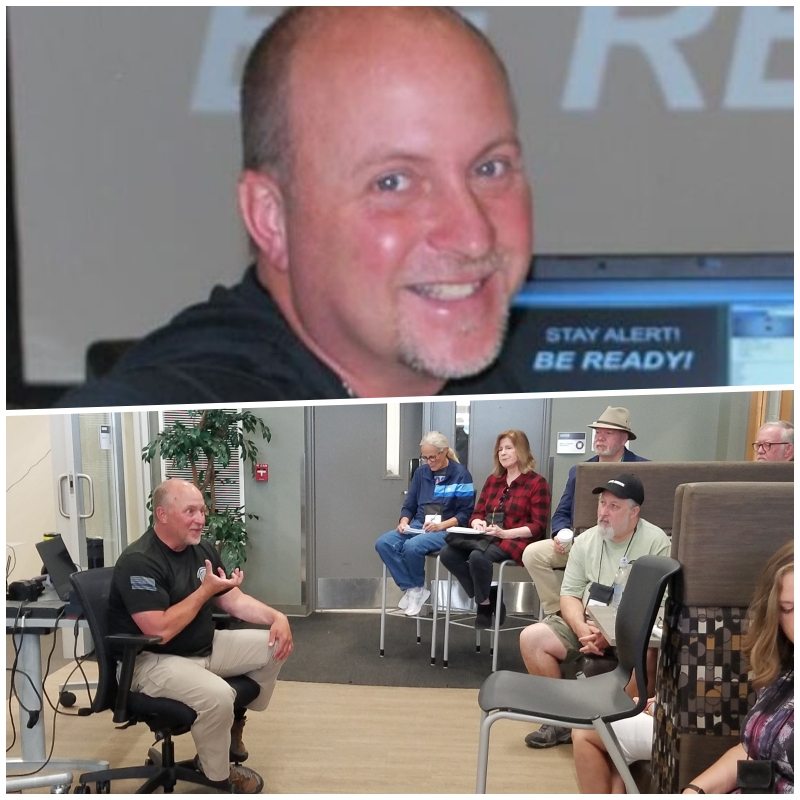
Eric Walters – Writers’ Police Academy
Erik Walters is the Public Safety Training Complex Specialist at Northeast Wisconsin Technical College. In that role, Erik oversees all the public safety training facilities and equipment at 4 different locations. He’s also a Public Safety Training Academy instructor. Prior to coming to the college Erik spent 15 years at the Manitowoc Police Department, where he attained the rank of patrol sergeant.
Erik is a Wisconsin Department of Justice certified instructor in Defensive and Arrest Tactics, Vehicle Contacts, Scenario, EVOC, Tactical Response, Physical Fitness, and Firearms.
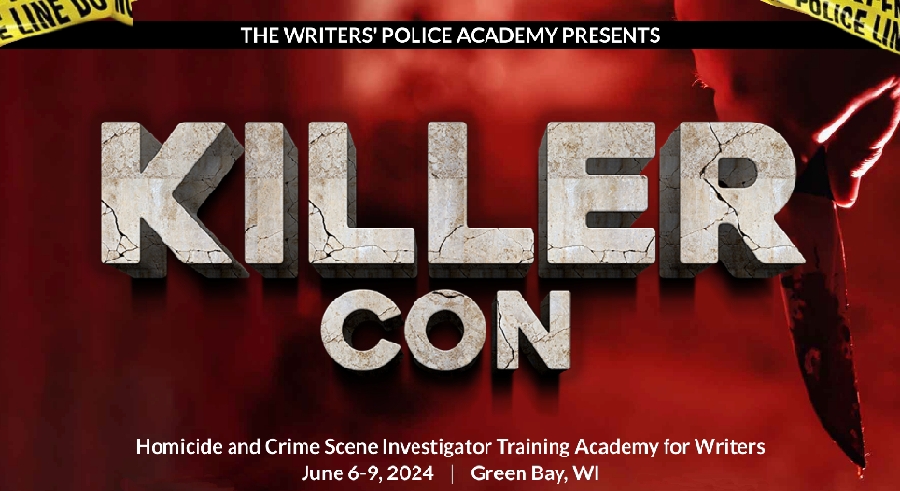
Spaces at this unique and exciting event are limited and will be filled on a first-come first-served basis. To claim your spot I strongly urge you to sign up right away. The 2023 Writers’ Police Academy event was sold out!
We also urge you to make your hotel reservations ASAP. We’ve already had to extend the room block!! There is no sister hotel available for overflow.
2024 Guest of Honor
Killer Con is extremely pleased to announce that internationally bestselling author Charlaine Harris is our 2024 Guest of Honor.
Charlaine delivers her keynote talk at the Saturday night banquet, and she will sign copies of her books immediately afterward.

Special Guests Include:
Dr. Katherine Ramsland – bestselling author and expert on forensic psychology and serial killers.
Robert Bruce Coffin – former detective sergeant (homicide and violent crime) and award-winning mystery author.
Carrie Stuart Parks – bestselling author and internationally recognized forensic artist who is the most widely known instructor of forensic art in the world.
Michael A. Black – Chicago area police sergeant – homicide, SWAT, investigations (ret.), and bestselling author of both fiction and nonfiction.

On-Site Crime Scenes and Hands-on Workshops
Killer Con is a hands-on training event for writers, with classes taught by top forensic experts and DOJ-certified law enforcement instructors.
Classes and workshops begin on Friday, starting with a live shooting scene response scenario. Participants will see the event unfold in real-time as first responders, detectives, EMS, the coroner, and others arrive in response to a 911 call where the frantic caller states, “Help, someone’s been shot … I think they’re dead!”
Next, Dr. Katherine Ramsland hosts a murder scene where Killer Con attendees learn particulars about the crime and then explore the scene to determine the evidence needed to solve the case. Following Katherine’s workshop, participants attend classes and hands-on training sessions on Friday and Saturday. Information and techniques learned in these sessions provide the tools to solve this case and others.
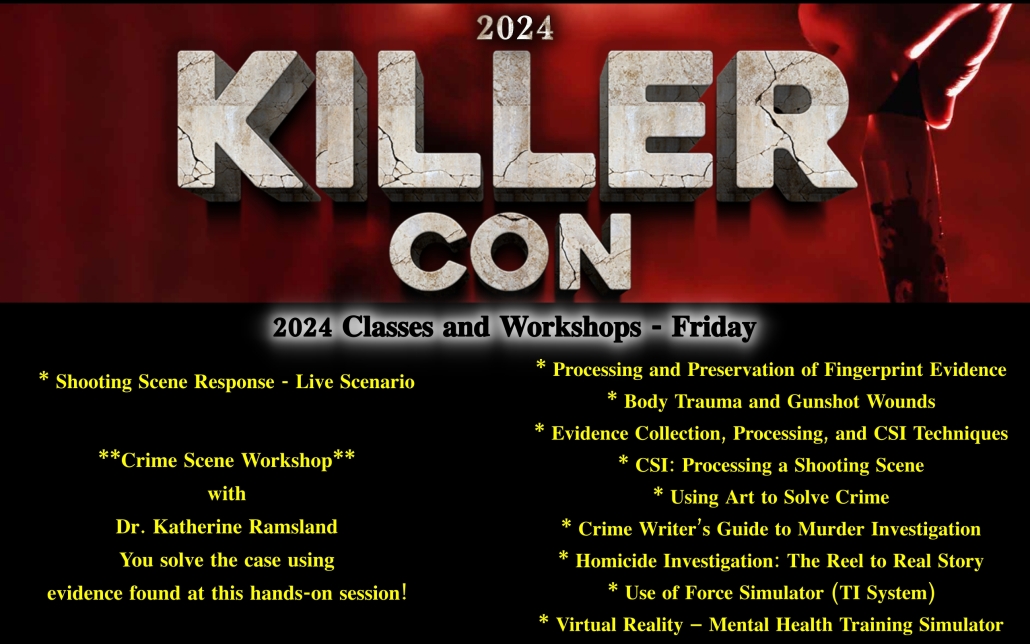
Did You Solve the Case?
At the conclusion of Saturday classes, Dr. Ramsland reveals the case details from Friday’s Crime Scene Workshop. Attendees will then know if they solved the case or not.
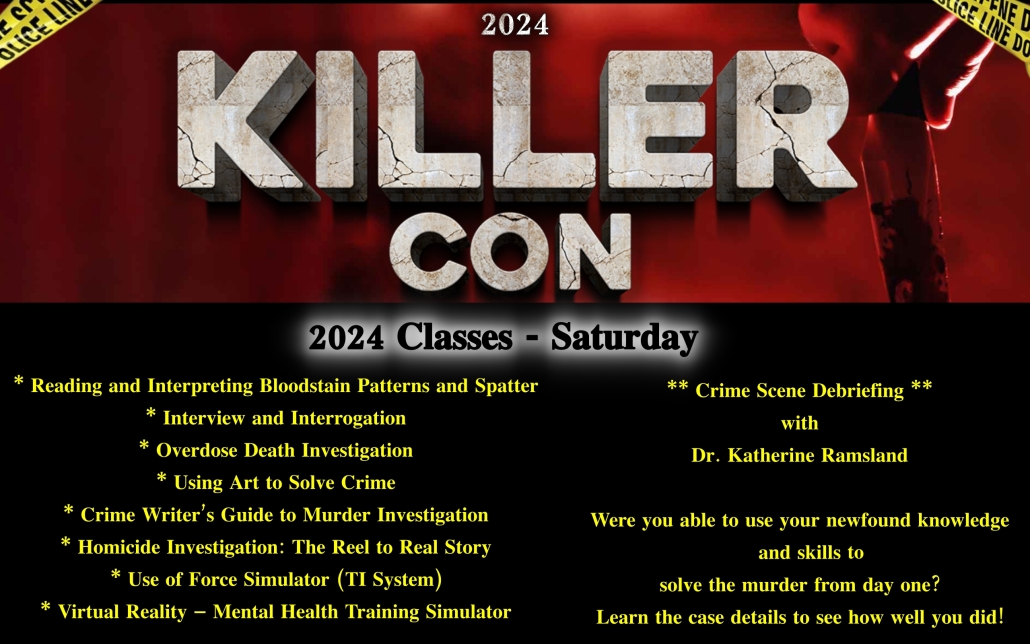
… And More!
Killer Con begins Thursday at noon with a massive indoor “Touch-a-Truck” event featuring a variety of public safety vehicles, fire apparatus, CSI Unit, drones, SWAT vehicles and equipment, and other items for attendees to view, examine, and explore. Officers, firefighters, and other experts will be available for Q&A and live demos.
Thursday night ends with forensic artist Carrie Stuart Park’s session Don’t Lie To Me, a forensic study of the language of deception.
Friday evening features Dr. Katherine Ramsland’s presentation, Encounters with Killers.
Saturday ends with a banquet and keynote address by guest of honor Charlaine Harris. A book signing follows her talk.
Killer Con festivities end on Sunday with a fun and informative panel discussion with experts who answer attendees’ questions.
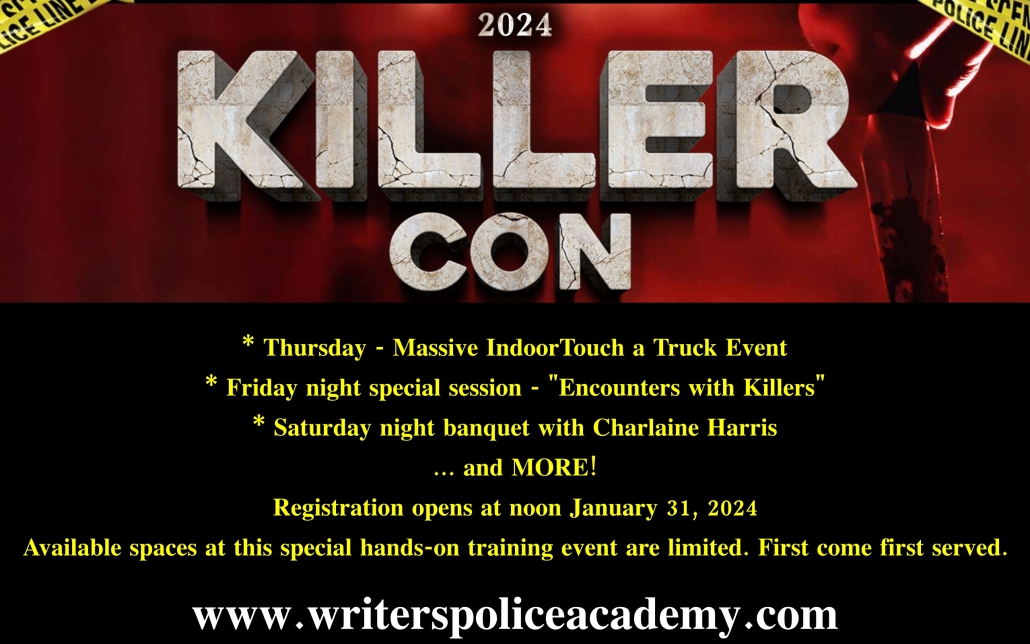
Click to watch the Killer Con promo video below. Please turn on the sound and watch to the end.

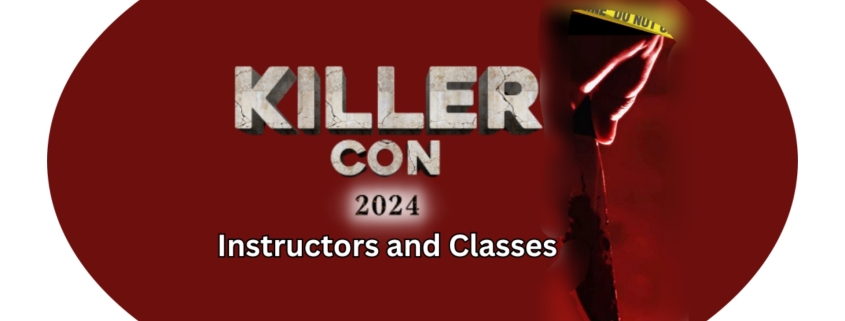
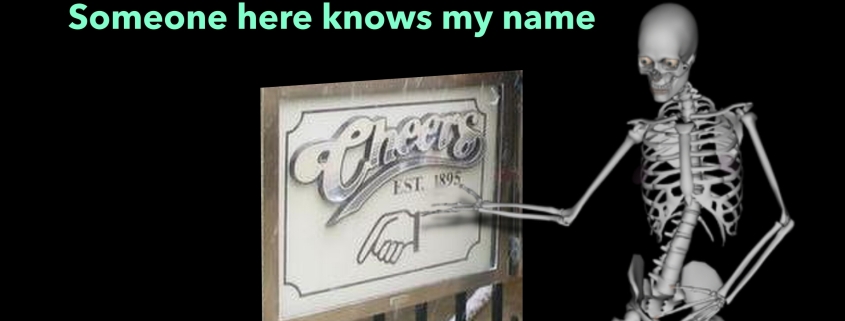
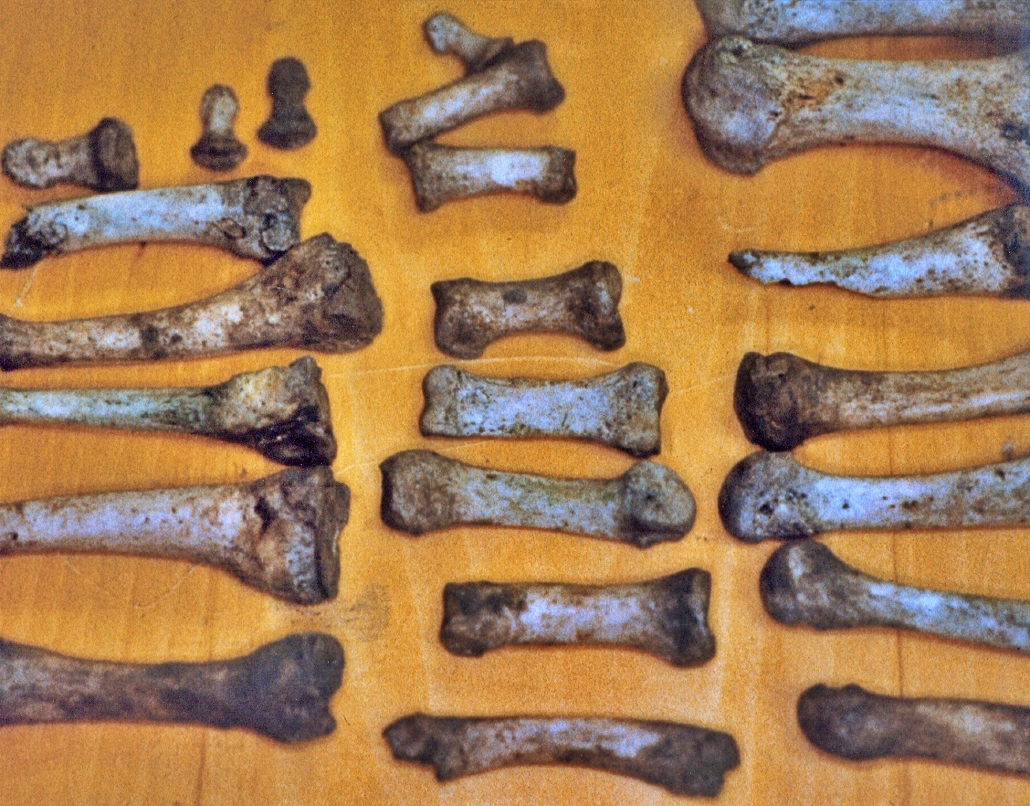
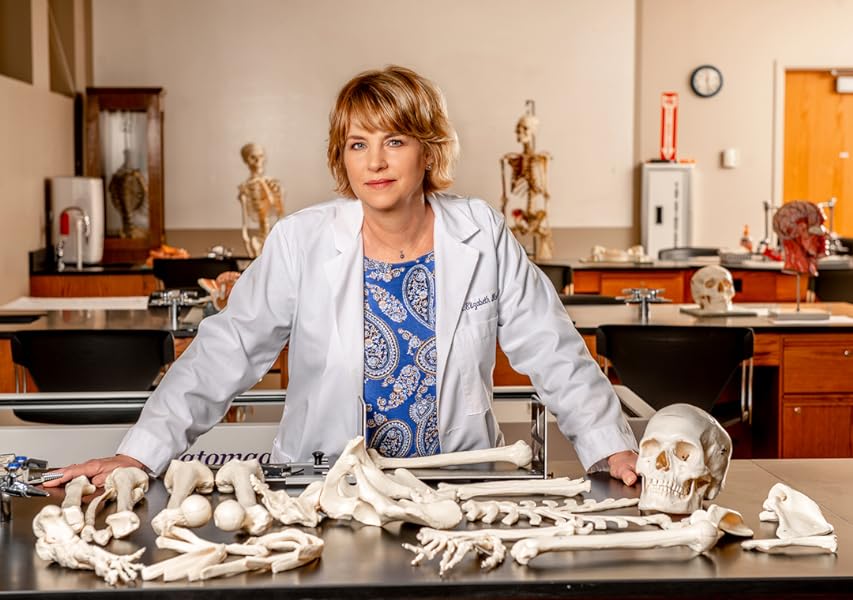 In 2012 Dr. Elizabeth Murray was a featured presenter at the
In 2012 Dr. Elizabeth Murray was a featured presenter at the 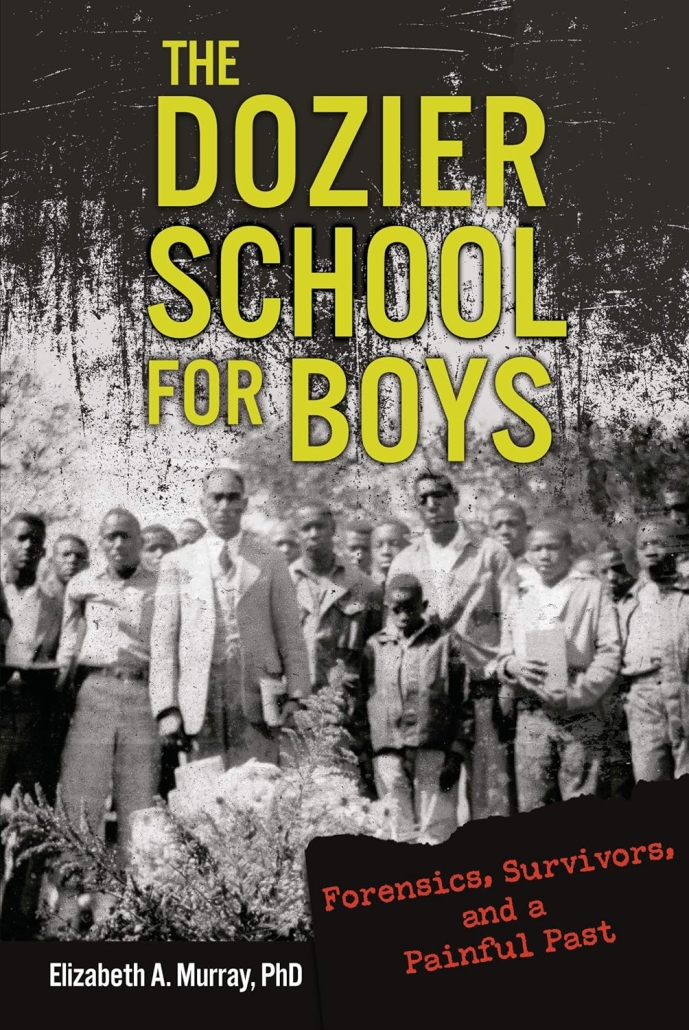


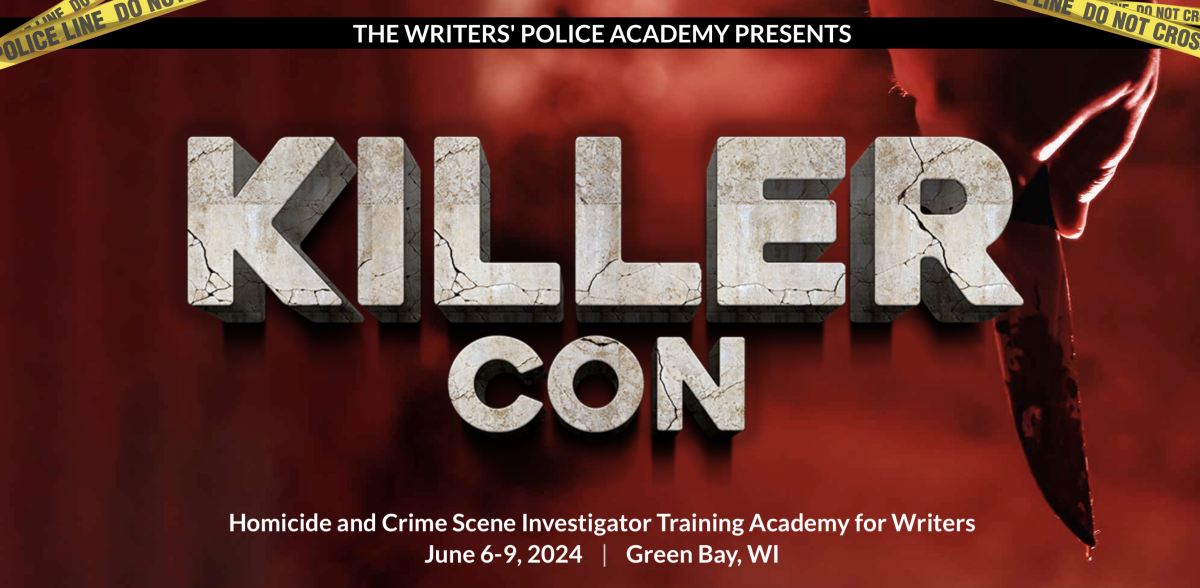
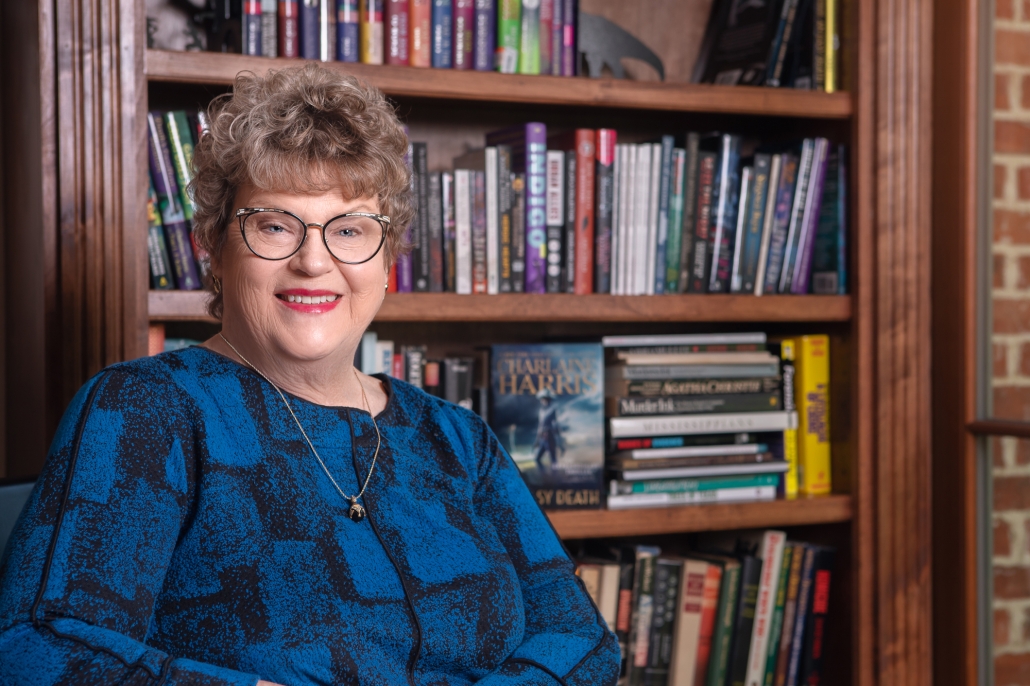

 “I. Know. My. Rights, you fat dumbass son of a whore doughnut-eating pig! No offence to pigs, mind you. You work for me. I pay your salary. I’m gonna have your job and I’m gonna sue you and your mama and I’m gonna take your houses and cars and your pension and your mother’s Social Security checks. You gotta let me go. This arrest is illegal ’cause you didn’t read me my rights! Now take off these cuffs … NOW … afore I open a can of whupass on you like you ain’t never seen!!!!”
“I. Know. My. Rights, you fat dumbass son of a whore doughnut-eating pig! No offence to pigs, mind you. You work for me. I pay your salary. I’m gonna have your job and I’m gonna sue you and your mama and I’m gonna take your houses and cars and your pension and your mother’s Social Security checks. You gotta let me go. This arrest is illegal ’cause you didn’t read me my rights! Now take off these cuffs … NOW … afore I open a can of whupass on you like you ain’t never seen!!!!”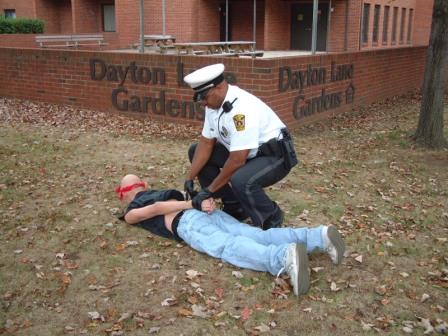
 Fact: The Miranda warning requirement stemmed from a case involving a man named Ernesto Miranda. Miranda killed a young woman in Arizona and was arrested for the crime. During questioning Miranda confessed to the slaying, but the police had failed to tell him he had the right to silence and that he could have an attorney present during the questioning. Miranda’s confession was ruled inadmissible; however, the court convicted him based on other evidence.
Fact: The Miranda warning requirement stemmed from a case involving a man named Ernesto Miranda. Miranda killed a young woman in Arizona and was arrested for the crime. During questioning Miranda confessed to the slaying, but the police had failed to tell him he had the right to silence and that he could have an attorney present during the questioning. Miranda’s confession was ruled inadmissible; however, the court convicted him based on other evidence.